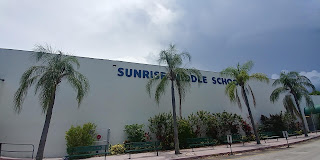 |
| Sunrise Middle School today |
By Jane Feehan
Fort Lauderdale needed schools in the 1950s. The city led
the state in population growth by the middle of that decade. Plans for Sunrise
Junior High School materialized after Fort Lauderdale pioneer and realtor M.A.
Hortt donated his property at 1750 N.E. 14 St., not far west of Federal Highway.
In
May 1956 the Broward County School Board awarded a construction contract to
Miami’s J.S. Stephens and Sons for $563,735, lower than the estimated $600,000
to $800,000 for this new facility. Population
growth was expected to continue at the same rate so at that May meeting the board
also approved the cost of stockpiling lumber for 30-35 portable classrooms of a
100 portable classroom county-wide project.
Plans for the new Sunrise Junior High (sixth through eighth
grades) included a large patio, larger than the one at the old Fort Lauderdale
High School, 24 classrooms, a physical education building, library, “cafetorium,”
a home economics room and an administration/music building. About 500 students attending the Naval Air
Station Junior High were expected to move to Sunrise Junior High when it was
contracted for completion by Feb. 1, 1957. The school was designed for 750
students but 1,000 were expected to enroll.
Construction was behind by early October 1956. Only 35
percent was completed with 50 percent of the contracted time behind them. Sunrise
Junior High did not open on time, but a month later, on March
4, 1957 with Mr. J.A. Wilkins as principal. Bus transportation was provided for
students two miles beyond the school.
In a board meeting back in January, 1956 members
had asked for a report or feasibility study on avoiding early opening of county
schools to cope with peak traffic and—get this one—from opening early on “cold,
damp mornings” (in Florida?). Those possibilities did not materialize because, other
than being unreasonable, it became moot. By August 1957, mere months
after opening, Sunrise Junior High was busting at the seams (as were others).
It operated split or double sessions as they awaited completion of 16 portable
classrooms. The proposed late openings for cold, damp days and traffic morphed quickly into the need to get students at school (s) earlier.
Today, about 1,350 students attend Sunrise Middle School, a
Montessori Magnet School. Baseball, basketball, golf, soccer, track and field are
offered. There’s a pool on the expanded campus, but it’s not operated by Sunrise
Middle School. The campus has grown. Sunrise Middle School is now painted in white with blue trim. And about its newspaper, for which I once served as assistant editor … it’s long gone.
 |
| Sunrise Middle today |
Sources:
Fort Lauderdale News, Jan. 6, 1956 Fort Lauderdale News, May 26, 1956
Fort Lauderdale News, Oct. 4, 1956
Fort Lauderdale News, May 1, 1957
Fort Lauderdale News, Aug. 30, 1957
Sunrise Middle School Administration – thank you.
Tags: Fort Lauderdale middle schools, Broward County
schools in the 1950s, Fort Lauderdale school history, Sunrise Middle School,
Jane Feehan, Fort Lauderdale in the 1950s





















